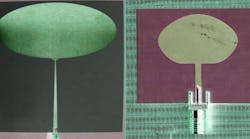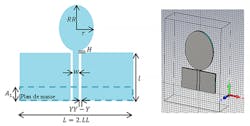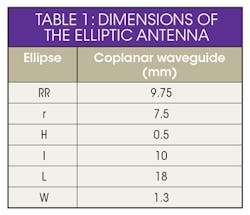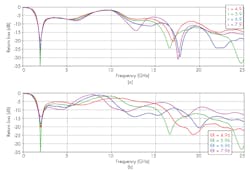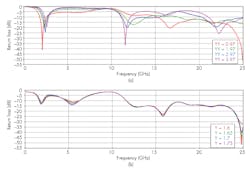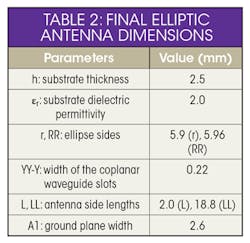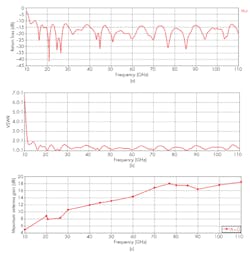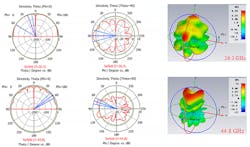Extending the Bandwidth of an Elliptical Monopole Antenna
Download this article in PDF format.
Wide-bandwidth antennas represent a more compact alternative to the use of multiple antennas to cover the same bandwidth. Numerous design approaches are available for achieving wide antenna bandwidth, including an elliptical monopole antenna developed by the authors. It consists of an elliptical patch fed by coplanar-waveguide (CPW) transmission line and matched to 50 Ω for wideband operation. The antenna was developed through comprehensive parametric studies and the design aid of the three-dimensional (3D) electromagnetic (EM) simulation software CST Microwave Studio from Computer Simulation Technology.
In a radio system, an antenna sends and detects electromagnetic (EM) waves and is considered one of the more important components in a wireless communications system.1 Numerous configurations are available for RF/microwave applications. One option, a planar monopole antenna, is a good candidate for wireless communication services because of its wide impedance bandwidth, omnidirectional radiation pattern, high radiation efficiency, and compact size.2,3
By designing a single antenna that can cover a large bandwidth, it can be used for various applications.4,5 A monopole antenna is one-half of a dipole antenna, almost always mounted above some sort of ground plane. Among the range of broadband monopole configurations that have been developed are circular, square, elliptical, pentagonal, and hexagonal forms (Fig. 1), which can easily be integrated into RF/microwave circuits as well as ultrawideband (UWB) devices.6-8
1. These drawings depict some of the different planar antenna geometries used for broad bandwidths.
When the planar radiating elements of a monopole antenna are etched on a dielectric substrate, a ground plane can be in the form of CPW transmission lines with the radiating elements or in the frame of the dielectric substrate. The radiating elements can be fed by a coaxial cable or microribbon line. Modifying the ground plane in certain ways can increase the antenna bandwidth. CPW enables good impedance matching, omnidirectional radiation patterns, and wide bandwidths at RF, microwave, and millimeter-wave (mmWave) frequencies. These CPW benefits make it a preferable method to feed antennas and to integrate with active devices.9
2. The design structure of the elliptical monopole antenna (left) and its key dimensions, such as l, LL, and h, is shown next to the antenna modeled in the CST Microwave Studio editor design and simulation software (right).
To achieve wideband frequency coverage, an antenna was designed based on an elliptical radiating disk fed by CPW. The antenna is designed on 2-mm-thick substrate material with high permittivity. Fig. 2 shows the initial design of this elliptical monopole antenna as it appears in the CST Microwave Studio computer design and EM simulation software from CST. The initial parametric values of the antenna are listed in Table 1.10
The return loss as a function of frequency for the initial monopulse antenna design is plotted in Fig. 3, although the performance can be improved. By experimenting with the antenna’s design parameters, the return loss can be optimized over a wide bandwidth while achieving a compact final antenna structure.
3. The return loss behavior is plotted versus frequency for the proposed broadband antenna.
Role of Substrate Thickness
The optimization process consists of a number of steps. The first step involves changing substrate thickness (h) in simulation in pursuit of broadband operation. After simulations with different substrate thicknesses, the results were plotted in Fig. 4. The resonance number for each curve is around 9. Substrate thickness is found to have a significant effect on antenna return loss. Bandwidth is found to increase linearly with increasing h, with the best results at h = 2.5 mm and with the bandwidth exceeding 9%.
4. This plot shows the influence of substrate thickness on return loss.
Knowledge of the effects of substrate dielectric permittivity on antenna performance can also be useful in optimizing the antenna design for broadband performance. For example, when the value of dielectric substrate permittivity is between 3.0 and 3.5, several resonant peaks appear at the higher frequencies, representing minimal reflected power levels and a slight increase in bandwidth (Fig. 5). The most interesting permittivity value is equal to 2, such that the return loss presents three resonances peaks with bandwidth exceeding 682.5 MHz for the third resonance frequency of 19.65 GHz.
5. This plot predicts the influence of substrate permittivity on return loss.
The effects of an antenna’s elliptical dimensions on its electrical behavior should also be examined when optimizing the antenna for wide bandwidth. Computer simulations were performed with Microwave Studio on different antenna configurations to better understand the effects of changing these dimensions.
The vertical half-side (RR) of the ellipse was first modeled to understand its influence over the frequency range from dc to 25 GHz. Then, a similar analysis was performed on the horizontal half-side (r) of the ellipse so that an ultrawideband structure could be created for the antenna. In this analysis, the two parameters h and εr previously studied remained fixed and equal to 2.5 and 2 mm, respectively, while parameters r and RR vary according to Figs. 6a and 6b.
6. These plots show the influence of the ellipse vertical side on return loss (a) and the influence of the ellipse horizontal side on return loss (b).
Variations in the ellipse dimension r have a comparable effect to what was observed in the case of parameter RR for the elliptic monopole. The two return-loss curves determined mainly by the dimensions r = 5.9 mm and RR = 5.96 mm are almost identical where the bandwidth is greater at 982.5 MHz. As a result, it can be determined that these changes will have a significant impact on adapting an antenna to broad bandwidth use.
Sizing Up CPW Slots
By means of the CPW slot width inserted next to the feed line, it was possible to understand the contributions of that slot width on antenna return loss. The width of the slot is limited in practical terms by the positions Y and the multiple YY positions along the abscissas axis, and ultimately determined by the difference between positions Y and YY.
7. The size of the gap between antenna position YY (a) and Y (b) dictates the performance of the antenna in terms of return loss.
Setting the YY parameter was found to essentially impact the antenna bandwidth, the resonant frequency, and the amplitude of the antenna. Plotting the YY parameter versus Y values as in Fig. 7b, the bandwidth can be found to increase with the size of the gap between the two positions. The slot width that appears most attractive for optimum bandwidth is around 0.22 mm (from 1.97 to 1.75 mm), for which the antenna presents a bandwidth of 11.65 to 25.00 GHz with a return loss (S11) of better than −10 dB (i.e., for a bandwidth that exceeds 1335 MHz rather than 982.5 MHz).
To better understand the influence of the antenna lateral lengths (LL), they were reduced from 9.6 mm to 9.0 mm to investigate the effects of the smaller dimension on electrical performance. The bandwidths for the reductions in size, from 9.6 mm to 9.4 mm to 9.2 mm, are relatively similar, with each exhibiting its own return-loss characteristics. The return loss for LL = 9.4 mm has two peaks of better than −40 dB and a bandwidth exceeding 1305 MHz. Fig. 8 shows the simulated return loss for antenna designs with reductions in side lengths (LL) from 9.6 to 9.0 mm.
8. The antenna side lengths also have an impact on its return-loss performance across a wide bandwidth.
As part of exploring the influence of the ground plane length on antenna electrical performance, it was changed from 2.6 mm to 3.2 mm in 0.2-mm steps as illustrated in Fig. 9. The initial value of the ground plane width (A1 = 2.6 mm) yields an antenna return loss of less than −57.58 dB at the desired frequency of 16.3 GHz, while other configurations (A1 = 2.8 mm, 3.0 mm, and 3.2 mm) present lower-level return-loss peaks.
9. The length of the ground plane also has a bearing on the antenna’s ultimate return-loss performance.
By means of this parametric study of the elliptical antenna, it was possible to achieve broadband operation in its high-frequency range. The final parameter values of the antenna used for broadband operation are summarized in Table 2, with the final antenna simulation performed in the frequency range from 10 to 110 GHz. According to Fig. 10, where the bandwidth exceeds 98.10 GHz, this optimizing of antenna parameters for wide bandwidth is one approach for achieving a fundamental antenna design with broad bandwidth.
10. This is the final elliptic monopole antenna structure as it appears in the CST Microwave Studio editor.
Figures 11a, 11b, and 11c depict the return loss, voltage standing wave ratio (VSWR), and gain of the final antenna design, respectively.
11. The plots show return loss (a), VSWR (b), and gain (c) within the antenna’s wide bandwidth.
The return loss (|S11|) amplitude usually provides details on an antenna’s various resonances, its bandwidth, and its adaptation. The return loss curve of the optimized antenna is adapted perfectly between 11.9 and 110.0 GHz. Therefore, final structure exhibits better behavior than obtained at the beginning of the design process by simulating the proposed antenna with the indicated new parameters of Table 2. The consequences of modifying the antenna parameters result in the wide bandwidth, which exceeds the 98.10 GHz to a resonance level of −10 dB.
Fig. 11b plots the VSWR for the wideband antenna design. The VSWR can be seen as stable and coherent, with a value lower than 2.0:1 starting from the level of 11.9 dB at the resonance frequency. Fig. 11c shows the gain versus frequency for the elliptical monopole. The gain increases with frequency from 5 dB at 10 GHz until reaching 18.45 dB at 110 GHz. The trend of increasing gain with increasing frequency indicates that this antenna design is well-suited for a wide bandwidth.
Fig. 12 shows 2D and 3D radiation patterns for some of the resonant frequencies of the elliptical monopole antenna, for φ = 0º and θ = 90º (plane E) at the resonant frequencies of 10 GHz, 26.3 GHz, 44.8 GHz, and 85.3 GHz. For plane E, the angular widths at 3 dB are around 39.2º, 49.3º, 16.2º, and 12.8º for 10.0, 26.3, 44.8, and 85.3 GHz, respectively. For θ = 90º, the secondary lobes can be clearly seen in the 3D radiation patterns. The mainlobe amplitudes for each frequency are 8.6, 8.1, 13, and 17.7 dBi for 10.0, 26.3, 44.8, and 85.3 GHz, respectively.
12. These 2D and 3D radiation patterns were plotted for the elliptic monopole antenna at many different frequencies within its range.
As wireless communications networks continue to develop, the demand will grow for broadband components, such as antennas. To better understand how a particular form of antenna structure could be modified for broadband use, an elliptical monopole antenna was studied to learn what structural changes would result in more broadband operation. The antenna was simulated with the aid of CST Microwave Studio simulation software. Analysis was performed on the antenna feed, radiating element, and the ground plane to enhance the design for broader-bandwidth operation. Through this analysis, it was possible to adapt the basic design of the antenna to a broad bandwidth exceeding 98.10 GHz.
References
1. K. N. Dhirgham, “An Alternative Look to Design of Wideband Planar Monopole Antennas Based on Parasitic Elements for C-band Wireless Applications,” International Journal of Electromagnetics and Applications, Vol. 4, No. 3, 2014, pp. 61-69, Department of Electronic and Communications Engineering, College of Engineering, Alnahrain University, Baghdad, Iraq.
2. R. Singh and G. Kumar, “Broadband planar monopole antennas,” M. Tech Credit Seminar Report, Electronics System Group, Electrical Engineering Dept., International Institute of Technology (IIT) Bombay, Bombay, India, November 2003.
3. R. P. Roopesh and S. Bharti, “Printed monopole antenna technology for wideband applications,” International Journal of Students Research in Technology & Management, Vol. 3, No. 5, May 2015, pp. 377-381, ISSN 2321-2543, Department of Electronics & Telecommunication, Mumbai, India.
4. K. P. Ray, “Design Aspects of Printed Monopole Antennas for Ultrawideband Applications,” International Journal of Antennas and Propagation, Hindawi Publishing Corp., Article ID 713858, Volume 2008.
5. K. P. Ray, S. S. Thakur, and S. S. Kakatkar, “Bandwidth Enhancement Techniques for Printed Rectangular Monopole Antennas,” IETE Journal of Research, Vol. 60, No. 3, 2014, 60:3, pp. 249-256.
6. Saswati Ghosh, “Performance Analysis of Different Ultra Wideband Planar Monopole Antennas as EMI Sensors,” International Journal of Electronics and Communication Engineering, Vol. 5, No. 4, 2012, pp. 435-445, ISSN 0974-2166.
7. Professor P. A. Chaudhari, Snehal R. Gaykhe, Aishwarya N. Darekar , and Swati K. Bagal, “Printed Circular Monopole Antenna,” International Journal of Innovative Research in Computer and Communication Engineering, Vol. 5, No. 2, ISSN (online): 2320-9801, February 2017.
8. A. Chami, “Miniaturisation et Intégration d’Antennes Imprimées pour Systèmes Communicants ULB Pulsés,” Thèse de Doctorat en Sciences Option Electronique, Université de Nice-Sophia Antipolis, November 25, 2011.
9. Sarawuth Chaimool and Prayoot Akkaraekthalin, “CPW-Fed Antennas for WiFi and WiMAX, Advanced Transmission Techniques,” WiMAX, Dr. Roberto Hincapie, Ed., ISBN: 978-953-307-965-3, available from Intech Open, http://www.intechopen.com/books/advanced-transmission-techniques-in-wimax/cpw-fed-antennas-forwifi-and-wimax, 2012.
10. N. Fortino, “Conception et Caractérisation d’Antennes Imprimées pour Systèmes Ultra Large Bande Impulsionnels,” doctoral thesis, February 16, 2006.
